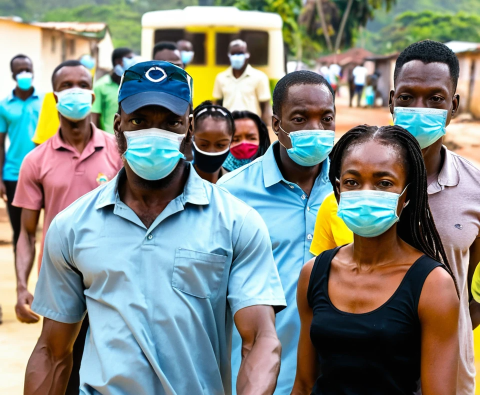Saharan Dust and the Caribbean’s Seasonal Struggle: A Public Health Crisis We Can’t Keep Ignoring

Every year, like clockwork, the skies over Kingston shift from blue to a hazy grey. It’s not a fire. It’s not pollution from our local factories. It’s something much older and far more powerful — a transatlantic visitor carried on desert winds: the Saharan Dust.
Known scientifically as the Saharan Air Layer (SAL), this phenomenon has evolved from a curious meteorological occurrence into a chronic health and environmental threat for Jamaicans. Yet despite the annual advisories and ODPEM’s well-intentioned warnings, we continue to treat this as a passing inconvenience instead of what it truly is: an escalating public health concern linked directly to our environmental vulnerability and weak systemic response.
An Invasion We Cannot Stop, But Must Prepare For
Originating more than 5,000 miles away in North Africa, this massive plume of dust — comprised of microscopic sand, dirt, fungi, bacteria, pollutants, and allergens — drifts across the Atlantic and settles over the Caribbean like an invisible shroud. Between May and October, it invades our air, clouds our skies, and penetrates our lungs.
It is not a question of if it will return — it will, year after year. The real question is: why do we continue to act like we’re surprised when it does?
A Silent Trigger for a Public Health Crisis
As an environmental and health professional, I can tell you the science is crystal clear: poor air quality kills. For people with asthma, COPD, sinusitis, and even cardiovascular disease, the Saharan dust is not just irritating — it is dangerous.
Jamaica has a high prevalence of asthma and respiratory allergies, particularly among children and the elderly. Each wave of dust increases hospital visits, disrupts school attendance, and overwhelms families already grappling with inadequate access to air-purifying devices or effective medications. And let’s be honest — how many households in low-income communities can afford a HEPA filter, or even an N95 mask?
We must recognize that dust management is not just a matter of personal responsibility, but a matter of national equity and public health planning.
Why Aren’t We Treating This Like the Hazard It Is?
The precautions listed by ODPEM are sensible — stay indoors, wear masks, monitor air quality — but they place the burden squarely on the individual. Where is the government-led support?
Where are:
· Public distribution programs for respiratory masks in vulnerable communities?
· Mobile clinics or hotlines to support those suffering severe symptoms during peak dust days?
· Nationwide school and workplace awareness campaigns on how to manage air quality inside homes and buildings?
· Environmental health reports to quantify the long-term impacts of repeated exposure?
Our approach continues to be reactive rather than proactive. And this passivity comes at a price — in the form of avoidable hospital admissions, missed workdays, and the slow degradation of public health.
Environmental Preparedness Is Health Preparedness
We speak often of hurricane season. We prepare for it. We budget for it. We drill for it. Yet Saharan Dust, which comes with far greater frequency and affects far more people, is met with little more than a press release and a prayer.
It is time to elevate dust preparedness to the level of climate and disaster management.
We must also begin investing in urban green infrastructure — more trees, rooftop gardens, and green walls — not only to cool our cities but to help naturally filter the air. Our cities must be redesigned to breathe better.
The Saharan Dust is a global phenomenon, yes — but its impact is local. In our homes. In our schools. In our hospitals. In our lungs.
We owe it to ourselves, and especially to our children and elderly, to stop treating this as a seasonal nuisance and begin treating it as a national health issue that demands sustained policy action, equitable support, and long-term investment.
Because clean air is not a luxury. It is a right.




